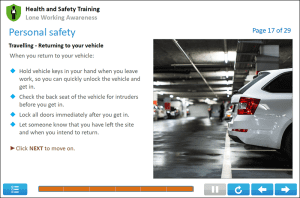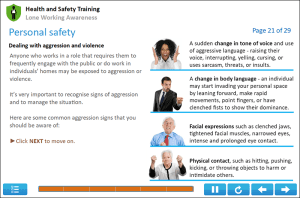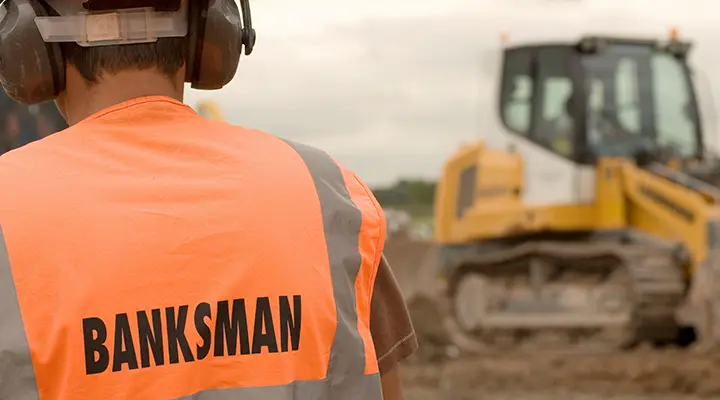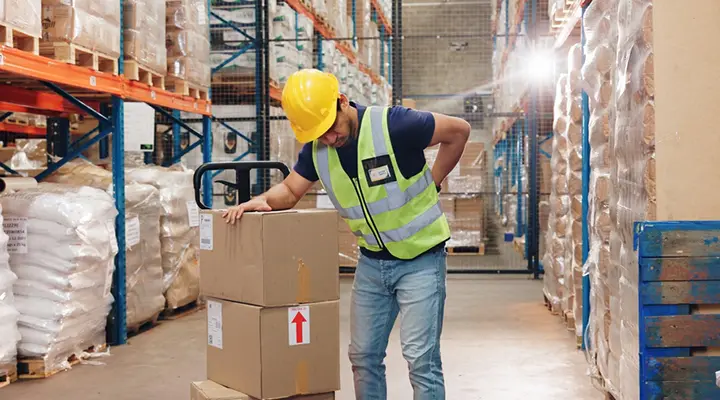A lone worker is an individual who works independently, without close or direct supervision and immediate support.
Employees across various industries may work alone in remote locations, isolated areas within larger facilities, or from home.
It is important to recognise if you are a lone worker so that you can take the necessary steps to safeguard yourself from potential hazards associated with lone working.
This article will outline the characteristics of lone workers and explore different occupations typically associated with working alone. We aim to clarify what it means to be a lone worker and help you determine whether you fall into this category.
What does lone worker mean?
The term lone worker does not always refer to someone who works alone, away from any other person. A lone worker is an individual who spends all or part of their working day without a colleague or teammate present.
Lone workers are those who:
- work alone away from a fixed workplace
- work in the same building or site as their colleagues but cannot be seen or heard by them
- work outside of regular working hours
- work alone with members of the public or in populated areas
- work from home (or work from co-working spaces with people from other organisations)
- travel alone during work hours
- are left alone for periods such as when their colleague takes a break
Who could be considered as lone workers?
Lone workers are found in all industries, and nearly any job involves working alone.
We will now explore various occupations that commonly involve lone working.
Click on an occupation below to see examples of activities in each job role that classify as lone working.
Bailiffs often work alone when they visit debtors' homes or businesses to collect debts or enforce court orders. Their job involves working independently to assess and remove items from debtors’ property, which means their presence is usually unwelcome. They may need to work in isolated or rural areas, outside regular work hours or weekends, without immediate backup or support.
Additionally, bailiffs may work alone for extended periods while gathering information about debtors.
Bus drivers mostly work alone. They may work alone during off-peak hours, like late at night or early in the morning. Also, when driving less popular routes, bus drivers may end up in isolated or rural locations and spend prolonged periods without contact with their colleagues.
In the case of mechanical issues or medical emergencies, they often need to handle the situation alone until their colleagues or emergency services arrive.
During scheduled breaks or downtime between routes, a bus driver may be alone on the bus, especially if they are not in a designated rest area with other drivers.
Many workplaces have a team of cleaners who work outside regular office hours, such as in offices, schools, or shops. These cleaners may be out of contact with each other, working at completely different ends of a large building. In smaller premises, a cleaner may work alone after their colleagues have gone home.
Domestic cleaners often work alone when they visit clients' homes to complete their work. They either need to do their job when the house is empty or when the clients are present.
A construction worker is a lone worker when they complete building work without a teammate nearby, operate machinery alone or work out of sight and sound of others, which is common in large and noisy construction sites.
In a smaller site, a construction worker may work alone if a job does not require assistance due to the scale or specification of the job.
Delivery drivers, including food delivery drivers, typically work alone. They drive their vehicles without a colleague and deliver packages or food to customers in residential areas. These drivers often work late at night or early in the morning and may spend significant time without interacting with their colleagues. Also, drivers may be alone in their vehicles while they wait for new delivery assignments or food orders.
Engineers, electricians, plumbers and decorators are considered lone workers when they work alone on short-term projects in clients’ homes. They may need to complete a specific task and do not require assistance.
They may also need to travel alone during work hours to the work site or to collect materials for their job, which also falls under lone working.
An engineer, electrician or plumber may need to respond to urgent repairs alone, such as a plumbing leak or electrical failure, where no other workers are available.
In addition, they are still considered lone workers if they work with a team in large sites such as commercial buildings but are situated in a distant area away from their colleagues where they cannot be seen or heard.
Estate agents and housing officers often work alone during home visits, inspections or property viewings. An estate agent may meet potential buyers at a property without any colleagues present, and a housing officer may conduct visits to assess living conditions or discuss tenant issues alone. Additionally, they may work outside office hours or on weekends, making them the only employees on duty.
A factory or warehouse worker is considered a lone worker when they operate in isolated sections of a factory or warehouse, such as storage areas or loading bays, where other workers are not present. They may also conduct inventory counts or stock checks in less frequented warehouse areas, where a colleague cannot see or hear them.
A farmer or forestry worker is considered a lone worker when they operate alone in remote fields, forests, or rural areas where no other workers are present.
They may be completing tasks such as planting, harvesting or tree felling alone if they don’t require assistance or are managing a specific land area.
A farmer or forestry worker is also a lone worker if they operate machinery such as a tractor or a combine, when they are physically separated from others.
Freelancers work independently, often from home or co-working spaces. They may have face-to-face meetings or consultations with their clients alone. In industries such as photography or event planning, freelancers work alone on-site. Additionally, they may attend networking events alone to make connections and promote their services.
Fuel station attendants are often lone workers. They may work alone during late-night or early-morning shifts and operate fuel stations in isolated areas such as motorway service stations. Sometimes they respond to emergencies, such as fuel spills when they are the only employee on duty.
A fundraising volunteer may be a lone worker when they go door-to-door to collect donations or carry out street collections. They may also visit local businesses for donations alone.
Additionally, a fundraising volunteer may work alone for extended periods while using social media platforms to raise donations.
Healthcare workers, including paramedics, nurses, midwives, health visitors and home care workers, may often work alone in various settings. They provide medical and personal care to patients in their homes, where the healthcare worker is alone with the patient and may not have immediate access to colleagues or supervisors. Healthcare professionals also conduct one-on-one consultations in private offices where they are alone with the patient. Additionally, they may need to respond to medical emergencies independently, without immediate support.
HGV drivers spend most of their working days alone and are an obvious example of lone workers. They often drive long distances and spend extended periods alone in the vehicle. HGV drivers deliver goods to remote locations like warehouses or construction sites, where they may have to unload without support. They often work during the night and may need to deal with vehicle breakdowns or accidents on the road where the driver may need to manage the situation alone until help arrives. Also, HGV drivers are alone when they take breaks, often in less populated locations such as service stations or lay-bys.
All homeworkers are considered lone workers, as they work independently, without close or direct supervision and immediate support from their colleagues. Homeworkers are classified as lone workers even if they are not physically alone at home.
There are various situations in the hospitality industry where employees may work alone, especially during late-night or off-peak hours. A hospitality worker might be the only employee working at a hotel, restaurant, or bar. They may need to deliver food or amenities to guest rooms alone, set up for events or functions or assist guests in isolated areas. Hospitality workers may also need to manage late check-ins alone and handle emergencies, such as a fire alarm without the presence of other staff.
A laboratory worker is a lone worker when they conduct experiments or research projects in a laboratory alone. They may also work outside regular working hours, without their colleagues nearby.
Also, laboratory workers may work in isolated laboratory settings, such as field laboratories or mobile labs, where they may be alone.
Although parking wardens work in public spaces, they usually work alone, without a colleague nearby. They may need to work alone in less populated areas or during off-peak hours. They often come face-to-face with disgruntled drivers who have received or are about to receive a penalty notice.
Both pet sitters and babysitters mostly work alone. Pet sitters may work alone while they take care of pets in their clients' homes and they may stay overnight. Similarly, babysitters care for children when their parents are away. If there is an accident or an emergency, they have no immediate access to colleagues to ask for help.
Police officers may sometimes work alone. For example, they might be responsible for patrolling a specific area alone, particularly in rural or less populated areas. Also, officers may have to respond to emergency calls or incidents alone, especially if a backup is not immediately available or they are the first to arrive at the scene. When conducting traffic stops, an officer may be alone with a driver in a vehicle. Moreover, officers may also have to manage paperwork, reports, or other administrative tasks alone, particularly if they work in an office without their colleagues.
A postman or postwoman typically works alone. They travel alone on assigned routes to deliver mail to various locations, sometimes in isolated or less populated areas, without their colleagues present. Also, they handle special or registered deliveries that require the postal worker to visit specific addresses alone and interact with recipients.
Additionally, a postal worker may sort and prepare mail in the post office during off-peak hours when no other staff members are available.
Retail workers and shop assistants are considered lone workers when they work in small shops, such as convenience stores or speciality shops and are the only employees on duty. They may work during early-morning or late-night shifts alone, for example when they need to clean or restock the store to prepare for opening when it is closed.
In large shops, a retail worker or shop assistant may work in isolated areas in a building without other staff nearby. For example, when they conduct inventory counts, assist customers in fitting rooms or when they receive deliveries alone.
Security guards often work alone on premises in remote locations, such as warehouses, or construction sites where no other security staff are available. If they work at events or venues, they may be assigned a specific area such as an entrance, to look after alone, without immediate backup. A guard may also work alone from a control room or security desk where they operate surveillance equipment. They often work out of regular working hours - late nights or early mornings - when they are the only guard on duty.
Social workers often make house visits as part of their normal daily activities. Whether supporting a family with a difficult child or visiting someone on probation, frequently they are alone and aren’t always welcome.
Social workers also interview individuals and families in private offices or community centres, where the social worker is without their colleagues.
Sometimes, they need to respond to urgent situations or crises, such as domestic violence or mental health emergencies, which may require them to handle the incident on their own without the immediate presence of their colleagues.
Taxi drivers spend most of their working days in their vehicles alone. They may need to work late at night or early in the morning when fewer colleagues are on duty. When a taxi driver travels on long-distance trips, they may spend extended periods with the passengers, particularly if the journey takes them to remote locations. If they need to deal with difficult passengers, taxi drivers often need to manage the situation alone, without the support of colleagues.
Additionally, during breaks or downtime between rides, a taxi driver is mostly alone in their vehicle, particularly if they are not in a designated rest area with other drivers.
Teachers and lecturers can be lone workers in various situations. For example, when they supervise after-school activities or conduct tutoring sessions without other staff members present. Also, they are lone workers when they hold student consultations in a private office or classroom when the teacher or lecturer is alone with students. Additionally, working alone in their classroom or office to prepare lessons outside of regular class hours or conducting online classes or lectures from home is also considered lone working.
Are you a lone worker?
If you identify as a lone worker, it is important to understand the responsibilities you and your employer have. Additionally, it is helpful to know your rights when working alone. We recommend checking out our article Lone Worker Training – Who is Responsible?
Protecting lone workers
HSE guidance explains how to keep lone workers healthy and safe. It is for anyone who employs lone workers, or engages them as contractors etc, including self-employed people or those who work alone.
Interested in lone working training?
Benefit from our CPD-certified Lone Worker Online Training Course. This course will help you understand the hazards associated with working alone and identify sensible precautions to keep yourself safe. Additionally, it will guide you on how to conduct a dynamic risk assessment.





